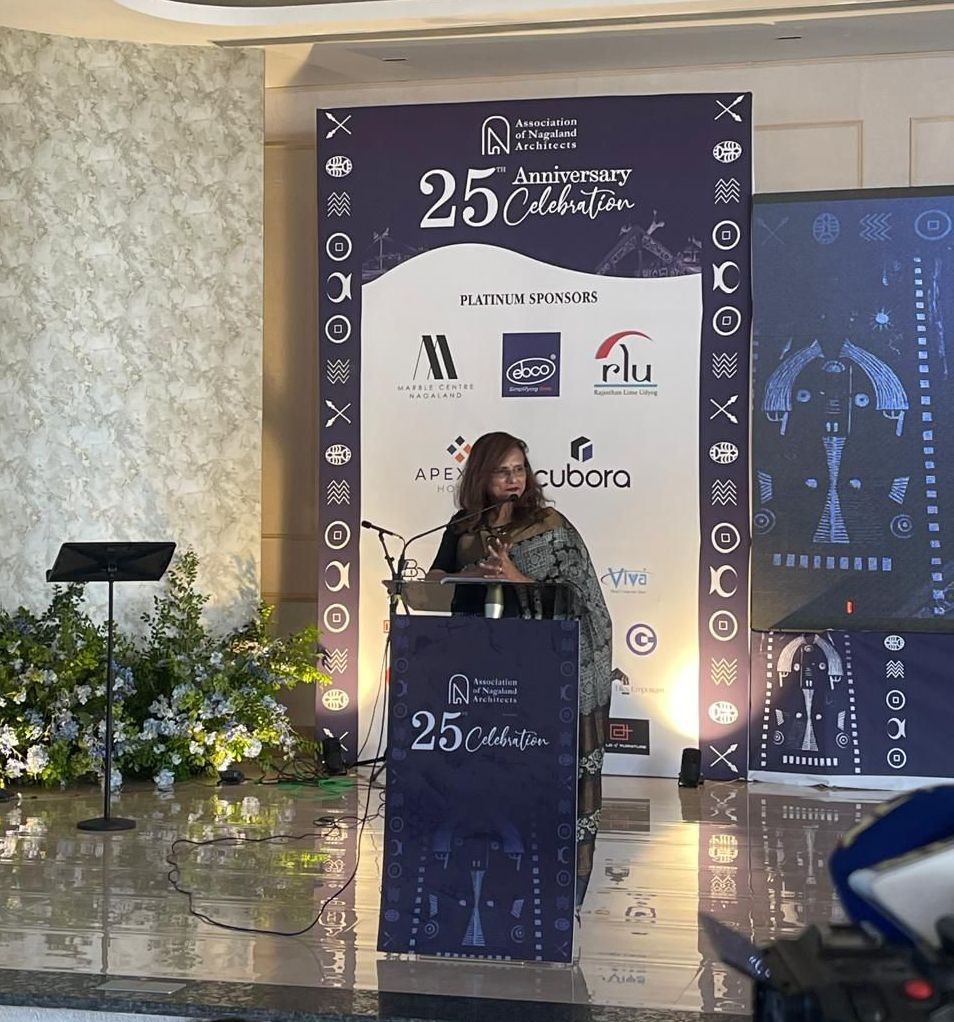Dr Gauri Nitin Shiurkar, Member of the Council of Architecture (CoA) and Vice-Chancellor of Symbiosis Skills and Professional University, addresses the Silver Jubilee celebration of the Association of Nagaland Architects at JP Park & Banquets, Naga United Village, Chümoukedima, on October 25. (Morung Photo)

‘Technology may draw lines, but humanity gives them meaning,’ Dr Gauri Nitin Shiurkar tells architects
Morung Express News
Chümoukedima | October 25
“You go to any city in India — Chennai, Pune, Mumbai, or Bengaluru — and stand on any MG Road, you won’t be able to tell which city you are in. All cities look the same because they are losing their identities,” remarked Dr Gauri Nitin Shiurkar, Member of the Council of Architecture (CoA), India.
However, Dr Shiurkar, who is also Vice-Chancellor of Symbiosis Skills and Professional University, noted that regions in the North East, particularly Nagaland, have managed to retain their distinct architectural and cultural identity.
“May they continue to do so,” she said, addressing the Silver Jubilee celebration of the Association of Nagaland Architects (ANA) at JP Park & Banquets, Naga United Village, Chümoukedima, on October 25.
The CoA member called Nagaland’s example inspiring for the rest of the country and urged architects to see it as “both an incredible opportunity and a great responsibility to preserve this identity while responding thoughtfully to the modern world.”
Nagaland’s architecture
Tracing the essence of Nagaland’s architecture, Dr Shiurkar described it as a profound reflection of its people — “resilient, deeply rooted, and richly expressive.”
She noted that the iconic Naga Morungs, with their intricate carvings and strong symbolism, are more than mere buildings; they are living expressions of community, identity, and collective wisdom.
Long before global discussions on green architecture began, Nagaland had been practicing it “naturally, intuitively, and beautifully,” she said. “What has always inspired me is the innate sustainability in Naga architecture — the way bamboo, timber, and stone are used gracefully, with deep respect for the climate and traditional craft.”
As a new generation of architects reinterpret these traditions, she expressed hope they would blend the wisdom of the past with the aspirations of the future.
Highlighting the ability to evolve without losing one’s soul, Dr Shiurkar stressed that architecture must go beyond constructing buildings to creating a sense of belonging. “Every line we draw, every space we shape should respond to people, culture, and the environment,” she said.
She noted that while cities across India are becoming increasingly uniform, regions like Nagaland offer valuable lessons in contextual and ecological design.
CoA’s vision for architectural education and practice
Expounding on the CoA’s broader vision, Dr Shiurkar outlined its commitment to strengthening architectural education, ethics, and professional practice nationwide through four strategic pillars.
The first is curriculum reform, aligning education with emerging technologies and global standards while remaining rooted in Indian realities.
The second is capacity building, ensuring that every architect, young or experienced, has access to lifelong learning, mentorship, and growth opportunities.
The third pillar emphasizes digital integration, building a national ecosystem connecting institutions and professionals through robust online platforms and knowledge networks.
The fourth focuses on promoting sustainable and inclusive design, championing architecture that is resilient, regenerative, and inclusive.
She also noted that the profession is being transformed by tools such as artificial intelligence, virtual modelling, and parametric design. “While technology may draw the lines, it is humanity that gives them meaning,” she emphasized.
Dr Shiurkar added that the CoA’s vision also stresses reinstating the moral and cultural role of architects as thinkers, innovators, and custodians of the built environment.
The future of the profession
Looking ahead, Dr Shiurkar said the future of architecture in India is both exciting and challenging, with urbanization, climate change, and social transformation redefining the architect’s role. She called on architects to collaborate closely with communities, policymakers, and technologists.
“For Nagaland, the opportunities are vast and inspiring,” she said. “With the state focusing on eco-tourism, rural development, and infrastructure, architects here can play a pivotal role in shaping the region’s future.”
She highlighted possibilities such as smart villages inspired by traditional settlement patterns, educational campuses celebrating indigenous culture, and public buildings that are energy-efficient and inclusive.
Dr Shiurkar also noted that bamboo architecture could become India’s global sustainability model and that Nagaland can emerge as a beacon of regional and sustainable architecture. “The Council of Architecture fully supports and encourages the architects of Nagaland to take this leadership role — setting an example for the rest of India,” she affirmed.
Addressing young architects and students, she reminded them that they are entering a world “full of tremendous opportunity as well as great responsibility.”
“Architecture will test your patience, creativity, and resilience. There will be long nights and tough days — but the joy you feel seeing your design come to life will make it worthwhile,” she said.
She urged them to “use technology wisely, but never let it overpower your imagination. Be innovative, but stay ethical. Dream big, but remain rooted.”
“Travel, observe, and learn from your land — the hills, the villages, the bamboo forests, and the craftsmanship that surrounds you. These are your greatest teachers. And always remember — your designs will outlive you. Design with conscience, compassion, and care,” she advised.
As ANA celebrates its Silver Jubilee, Dr Shiurkar urged members to look both back and forward. “Let this association continue to be a platform that unites, inspires, and elevates — a collective voice of architects who care deeply for their people and their environment,” she said, extending greetings on behalf of the CoA and herself.





